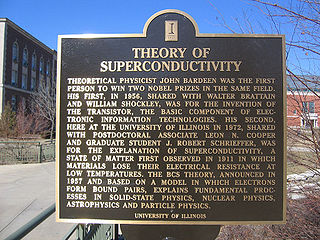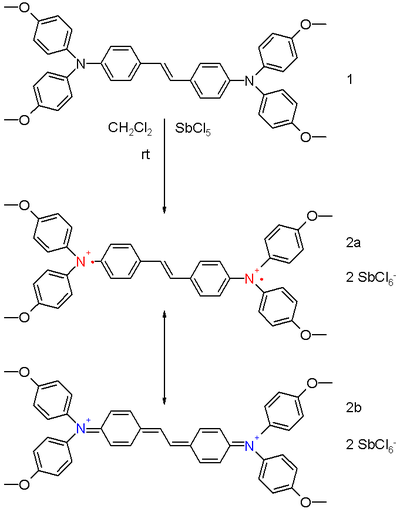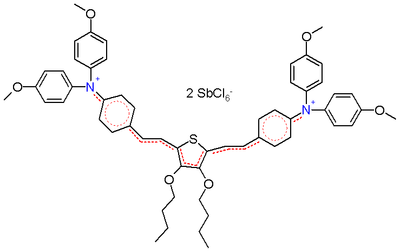
BCS theory or Bardeen–Cooper–Schrieffer theory is the first microscopic theory of superconductivity since Heike Kamerlingh Onnes's 1911 discovery. The theory describes superconductivity as a microscopic effect caused by a condensation of Cooper pairs. The theory is also used in nuclear physics to describe the pairing interaction between nucleons in an atomic nucleus.

In condensed matter physics, a Bose–Einstein condensate (BEC) is a state of matter that is typically formed when a gas of bosons at very low densities is cooled to temperatures very close to absolute zero. Under such conditions, a large fraction of bosons occupy the lowest quantum state, at which microscopic quantum mechanical phenomena, particularly wavefunction interference, become apparent macroscopically. A BEC is formed by cooling a gas of extremely low density to ultra-low temperatures.

In physics, a state of matter is one of the distinct forms in which matter can exist. Four states of matter are observable in everyday life: solid, liquid, gas, and plasma. Many intermediate states are known to exist, such as liquid crystal, and some states only exist under extreme conditions, such as Bose–Einstein condensates, neutron-degenerate matter, and quark–gluon plasma. For a complete list of all exotic states of matter, see the list of states of matter.

An exciton is a bound state of an electron and an electron hole which are attracted to each other by the electrostatic Coulomb force. It is an electrically neutral quasiparticle that exists in insulators, semiconductors and some liquids. The exciton is regarded as an elementary excitation of condensed matter that can transport energy without transporting net electric charge.

In condensed matter physics, a supersolid is a spatially ordered material with superfluid properties. In the case of helium-4, it has been conjectured since the 1960s that it might be possible to create a supersolid. Starting from 2017, a definitive proof for the existence of this state was provided by several experiments using atomic Bose–Einstein condensates. The general conditions required for supersolidity to emerge in a certain substance are a topic of ongoing research.

A fermionic condensate is a superfluid phase formed by fermionic particles at low temperatures. It is closely related to the Bose–Einstein condensate, a superfluid phase formed by bosonic atoms under similar conditions. The earliest recognized fermionic condensate described the state of electrons in a superconductor; the physics of other examples including recent work with fermionic atoms is analogous. The first atomic fermionic condensate was created by a team led by Deborah S. Jin using potassium-40 atoms at the University of Colorado Boulder in 2003.

A polaron is a quasiparticle used in condensed matter physics to understand the interactions between electrons and atoms in a solid material. The polaron concept was proposed by Lev Landau in 1933 and Solomon Pekar in 1946 to describe an electron moving in a dielectric crystal where the atoms displace from their equilibrium positions to effectively screen the charge of an electron, known as a phonon cloud. This lowers the electron mobility and increases the electron's effective mass.

A magnon is a quasiparticle, a collective excitation of the spin structure of an electron in a crystal lattice. In the equivalent wave picture of quantum mechanics, a magnon can be viewed as a quantized spin wave. Magnons carry a fixed amount of energy and lattice momentum, and are spin-1, indicating they obey boson behavior.

Lene Vestergaard Hau is a Danish physicist and educator. She is the Mallinckrodt Professor of Physics and of Applied Physics at Harvard University.
In particle physics hexaquarks, alternatively known as sexaquarks, are a large family of hypothetical particles, each particle consisting of six quarks or antiquarks of any flavours. Six constituent quarks in any of several combinations could yield a colour charge of zero; for example a hexaquark might contain either six quarks, resembling two baryons bound together, or three quarks and three antiquarks. Once formed, dibaryons are predicted to be fairly stable by the standards of particle physics.
The timeline of quantum mechanics is a list of key events in the history of quantum mechanics, quantum field theories and quantum chemistry.
A trion is a localized excitation which consists of three charged particles. A negative trion consists of two electrons and one hole and a positive trion consists of two holes and one electron. The trion itself is a quasiparticle and is somewhat similar to an exciton, which is a complex of one electron and one hole. The trion has a ground singlet state (spin S = 1/2) and an excited triplet state (S = 3/2). Here singlet and triplet degeneracies originate not from the whole system but from the two identical particles in it. The half-integer spin value distinguishes trions from excitons in many phenomena; for example, energy states of trions, but not excitons, are split in an applied magnetic field. Trion states were predicted theoretically in 1958; they were observed experimentally in 1993 in CdTe/Cd1−xZnxTe quantum wells, and later in various other optically excited semiconductor structures. There are experimental proofs of their existence in nanotubes supported by theoretical studies. Despite numerous reports of experimental trion observations in different semiconductor heterostructures, there are serious concerns on the exact physical nature of the detected complexes. The originally foreseen 'true' trion particle has a delocalized wavefunction (at least at the scales of several Bohr radii) while recent studies reveal significant binding from charged impurities in real semiconductor quantum wells.

Superfluidity is the characteristic property of a fluid with zero viscosity which therefore flows without any loss of kinetic energy. When stirred, a superfluid forms vortices that continue to rotate indefinitely. Superfluidity occurs in two isotopes of helium when they are liquefied by cooling to cryogenic temperatures. It is also a property of various other exotic states of matter theorized to exist in astrophysics, high-energy physics, and theories of quantum gravity. The theory of superfluidity was developed by Soviet theoretical physicists Lev Landau and Isaak Khalatnikov.
Solomon Isaakovich Pekar was a Soviet theoretical physicist, born in Kyiv, Ukraine. He was a full Member of the Ukrainian Academy of Sciences and is known for his fundamental contributions to condensed matter physics, especially for introducing and advancing the concept of polaron as a charge carrier in solids.

In quantum optics, a superradiant phase transition is a phase transition that occurs in a collection of fluorescent emitters, between a state containing few electromagnetic excitations and a superradiant state with many electromagnetic excitations trapped inside the emitters. The superradiant state is made thermodynamically favorable by having strong, coherent interactions between the emitters.

A Rydberg polaron is an exotic state of matter, created at low temperatures, in which a very large atom contains other ordinary atoms in the space between the nucleus and the electrons. For the formation of this atom, scientists had to combine two fields of atomic physics: Bose–Einstein condensates and Rydberg atoms. Rydberg atoms are formed by exciting a single atom into a high-energy state, in which the electron is very far from the nucleus. Bose–Einstein condensates are a state of matter that is produced at temperatures close to absolute zero.
In condensed matter physics, the quantum dimer magnet state is one in which quantum spins in a magnetic structure entangle to form a singlet state. These entangled spins act as bosons and their excited states (triplons) can undergo Bose-Einstein condensation (BEC). The quantum dimer system was originally proposed by Matsubara and Matsuda as a mapping of the lattice Bose gas to the quantum antiferromagnet. Quantum dimer magnets are often confused as valence bond solids; however, a valence bond solid requires the breaking of translational symmetry and the dimerizing of spins. In contrast, quantum dimer magnets exist in crystal structures where the translational symmetry is inherently broken. There are two types of quantum dimer models: the XXZ model and the weakly-coupled dimer model. The main difference is the regime in which BEC can occur. For the XXZ model, the BEC occurs upon cooling without a magnetic field and manifests itself as a symmetric dome in the field versus temperature phase diagram centered about H = 0. The weakly-coupled dimer model does not magnetically order in zero magnetic field, but instead orders upon the closing of the spin gap, where the BEC regime begins and is a dome centered at non-zero field.
The I. I. Rabi Prize in Atomic, Molecular, and Optical Physics is given by the American Physical Society to recognize outstanding work by mid-career researchers in the field of atomic, molecular, and optical physics. The award was endowed in 1989 in honor of the physicist I. I. Rabi and has been awarded biannually since 1991.
Tin-Lun "Jason" Ho is a Chinese-American theoretical physicist, specializing in condensed matter theory, quantum gases, and Bose-Einstein condensates. He is known for the Mermin-Ho relation.









